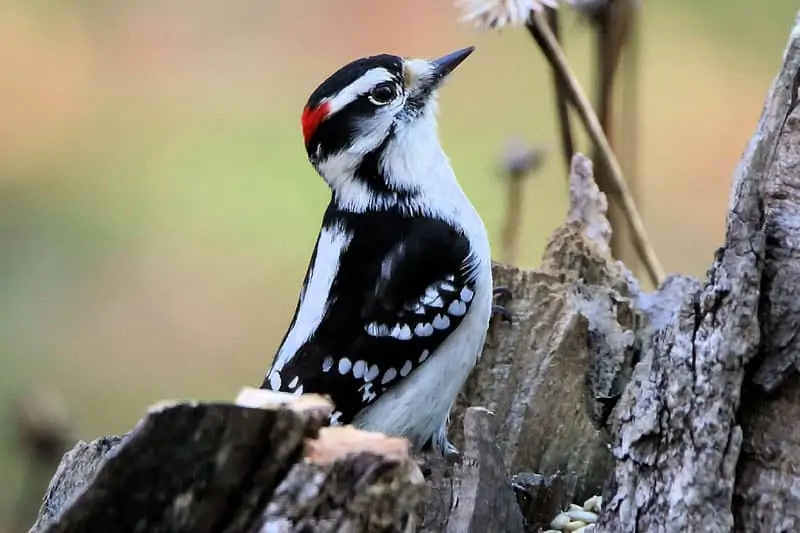Montana has some wonderful environments, as well as national parks. The state’s diverse population of wild birds is not surprising. We’ll look at a few of the more well-known and recognized birds in this article. Several of these species are migratory and only partially live in Montana, while others are permanent residents. We’ll learn a little about each species in this article by taking a look at 26 backyard birds in Montana.
I’ll then teach you how to entice them to your yard, give you a crash course in the 10 distinct types of bird feeders that may be utilized to do so, and even suggest a few Montana birdwatching destinations after that.
How many different species of wild birds are in Montana?
It’s difficult to say exactly how many bird species may be found in North America, the United States, or even in Montana. Yet, on the official list of the state of Montana, Wikipedia claims that at least 442 species of birds are found. According to one source, North America is home to 2,059 species; according to another, 914. So, although I don’t know how reliable these figures are, they do provide us with a broad idea of the number of species.
For the purposes of this article, we’ll simply examine a few of Montana’s most frequently seen (particularly in your garden) species.
26 BACKYARD BIRDS IN MONTANA
In Montana, we’ll take a look at 26 species of backyard birds, including some that are permanent residents and others that aren’t. These are just a few of Montana’s most visible and well-known backyard birds, but they are some of the more prominent and well-known. Let’s get started!
1. RED-WINGED BLACKBIRD

Scientific name: Agelaius phoeniceus
Length: 6.7-9.1 in
Weight: 1.1-2.7 oz
Wingspan: 12.2-15.8 in
Male red-winged blackbirds are easily identified by their crimson and yellow “shoulders,” which stand out against their dark bodies among the most common birds in North America. The females, on the other hand, are generally brown with pale streaks and bear a distinct appearance. Males of this species can father up to 15 distinct females, hence they are referred to as polygynous. Unfortunately, they may arrive at feeders in droves and devour seed right away.
Western Montana is home to red-winged blackbirds year-round, although they are primarily spring and summer visitors in the east.
Most types of feeders are visited by red-winged blackbirds, who will eat both seed and suet.
2. PINE SISKIN

Scientific name: Spinus pinus
Length: 4.3-5.5 in
Weight: 0.4-0.6 oz
Wingspan: 7.1-8.7 in
The beaks of pine siskins, a little finch species, are sharply pointed. They’re brown with white streaks that make them resemble female house finches in appearance. The wings and sides of the pine siskin’s tails will always be yellow (of varying brightness). Each winter after excellent seed harvests, they are considered nomadic, and their preferred food source is conifer seeds. As a result, you may see them in abundance one winter and not at all the next.
Throughout the year, pine siskins may be observed in the western section of the state, however they are only visible during the winter months in the east.
Nyjer (thistle) feeders are magnets for Pine Siskins, who may also consume millet or hulled sunflower.
3. BLACK-CAPPED CHICKADEE
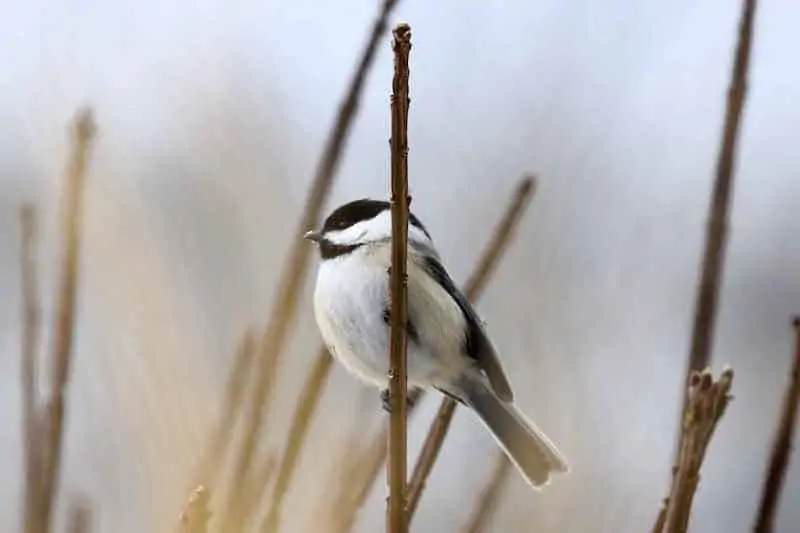
Scientific name: Poecile atricapillus
Length: 4.7-5.9 in
Weight: 0.3-0.5 oz
Wingspan: 6.3-8.3 in
Chickadees are small little birds with rounded bodies that have a “black cap” and a “black bib” that makes them easy to identify. Their underbodies are fluffy and light, with solid white cheeks and blackish gray wings and backs.
They are frequently seen darting back and forth from a feeder to cover and uncover for more at bird feeders. Chickadees are among the first birds I see at my yard’s new feeder, and they can be quite bold for their size!
Throughout Montana, black-capped chickadees may be observed year-round.
Most seed feeders will be visited by chickadees, who will provide them with a variety of seed blends.
4. BLACK-BILLED MAGPIE

Scientific name: Pica hudsonia
Length: 17.7-23.6 in
Weight: 5.1-7.4 oz
Wingspan: 22.1-24.0 in
The black-billed magpie resembles a jay in size but is shaped like a crow. Metallic blue on their wings and a long tail, black head, chest, and back. Bright white shoulder and sides. Fruit, grain, insects, small mammals, carrion, and eggs are among the foods that they consume. They’ve been spotted perched on the backs of huge animals like moose or deer, combing through their hair for ticks. These conspicuous birds perch on trees and on fenceposts in abundance, and they aren’t retiring. When they’re in a group, they may be quite boisterous.
In Montana, you may encounter black-billed magpies all year.
Black-billed magpies may visit backyards, although they prefer open rangeland. On a platform feeder, with suet, or by leaving out fruit such as orange halves, try to attract them with sunflower seeds and peanuts.
5. RED-BREASTED NUTHATCH

Scientific name: Sitta canadensis
Length: 4.3 in
Weight: 0.3-0.5 oz
Wingspan: 7.1-7.9 in
The backs of these small nuthatches are dark gray, the chest and belly are rusty (ranging from brilliantly colored to lightly colored), and the face is boldly black and white striped. These birds, which spend most of their time hopping around beneath the bark of trees and branches, are quick and active. They will utilize backyard nest boxes and nest in tree crevices.
Throughout the western and southern Montana borders, red-breasted nuthatches may be found year-round, but they are mostly winter birds. Because they frequently “follow the food,” their population seems to fluctuate seasonally, although depending on the conifer seed crop, it may appear quite abundant one year and sparse the next.
Feeders are visited by red-breasted nuthatches. Sunflower seeds, peanuts, or suet are all good options.
6. COMMON RAVEN

Scientific name: Corvus corax
Length: 22.1-27.2 in
Weight: 24.3-57.3 oz
Wingspan: 45.7-46.5 in
Solid black in color and rather large in size, Common Ravens are common. Like their cousins the crows, they are also renowned for their problem-solving skills. Living alongside human activity or in the middle of nowhere, they appear to be equally at ease. Ravens may produce a wide range of vocalizations, the most frequent of which is a succession of croaks.
Ravens are found year round in western Montana.
omnivorous, and since they are too big to fit into bird feeders, they rarely visit. However, make sure that your trash and outdoor pet food are not attracting flies.
7. AMERICAN ROBIN
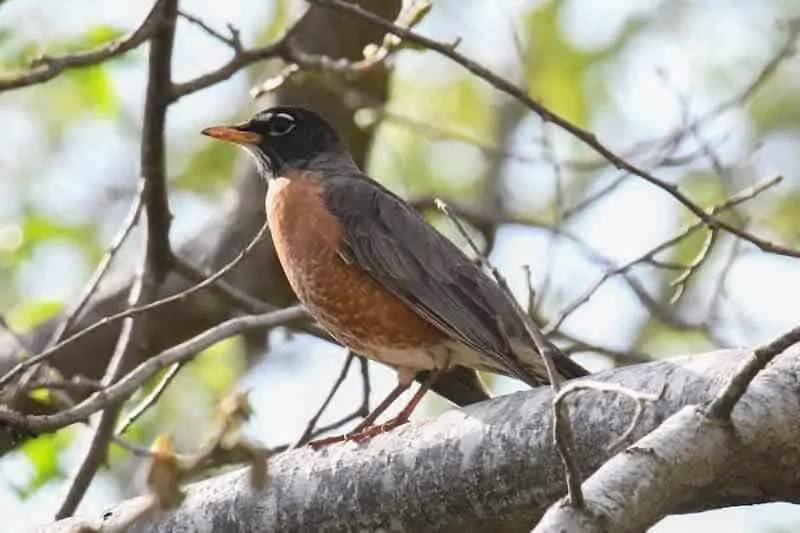
Scientific name: Turdus migratorius
Length: 7.9-11.0 in
Weight: 2.7-3.0 oz
Wingspan: 12.2-15.8 in
Robins are mostly seen hopping around the grass looking for worms and other invertebrates to eat, and they are quite common in backyards. They do not often eat seeds, despite visiting bird feeders on occasion. They are easily identified due to their bright red, spherical bellies and yellow beaks.
While you may not see robins as often in your yard during the winter, they live all year in Montana.
Mealworms, native fruit-bearing plants, leaf-litter for foraging, or a bird bath are all good ways to attract American Robins to bird feeders.
8. MOURNING DOVE

Scientific name: Zenaida macroura
Length: 9.1-13.4 in
Weight: 3.0-6.0 oz
Wingspan: 17.7 in
Dovecotes are small enough to sit perched on telephone wires or in clusters in trees, and they may be seen throughout the backyards. They prefer to lounge around beneath feeders and pick up the seeds that fall to the ground, so I often see them on my tray feeder. The top of mourning doves is gray, with black markings on top. The underside is pale peachy. The eye ring is pale blueish-gray, and the legs are pink.
Throughout the year, Western Montana is home to Mourning Doves, although they are only visible in the spring and summer.
Dove populations are attracted to seed feeders, but they prefer to search for fallen seeds on the ground. Sprinkle some seeds on the ground or try a ground feeder with a mixed seed blend.
9. EUROPEAN STARLING
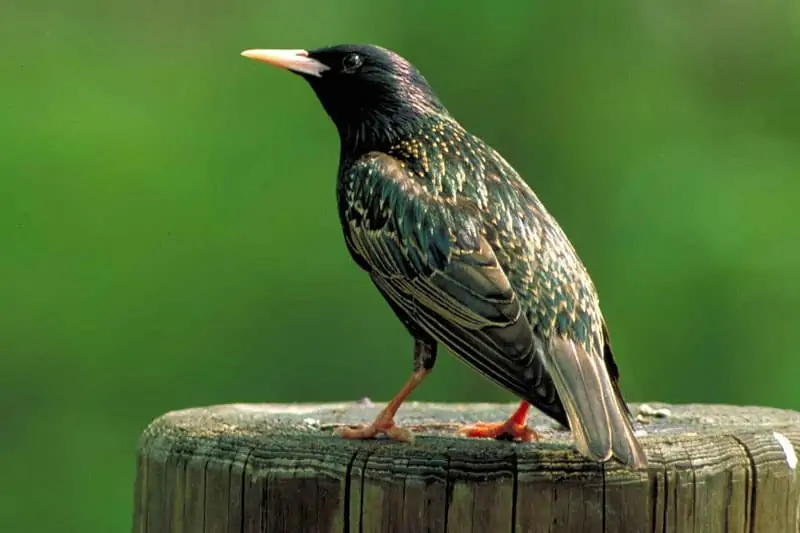
Scientific name: Sturnus vulgaris
Length: 7.9-9.1 in
Weight: 2.1-3.4 oz
Wingspan: 12.2-15.8 in
In the 1890s, 100 starlings were released in New York, and they have since overrun the nation. They’ll overtake feeders and destroy other birds’ nests, killing their young. They’ll also destroy other birds’ nests and kill their young. They have yellow beaks and feet and are generally dark with white specks on their backs and wings. While starlings appear black, they are iridescent and have lovely purple and green plumage in the right light.
While starlings are distributed throughout the country all year, Montana is no exception.
Almost anything, but especially suet, will be eaten by European Starlings. We recommend that you do not attempt to attract them, since they are an invasive species and will anyway appear.
10. AMERICAN GOLDFINCH

Scientific name: Spinus tristis
Length: 4.3-5.1 in
Weight: 0.4-0.7 oz
Wingspan: 7.5-8.7 in
When the bright yellow feathers are in the spring and summer, goldfinches are among my favorite birds to see at feeders. Breeding males during this time are predominantly yellow, also known as “gold,” with black-tipped wings and a black hat on top of their heads. Females and juveniles lack the black head and are not as bright yellow. They’ll molt throughout the winter, resulting in a duller brownish or olive tint. The black on their wings and beaks, as well as the finch-like shape of their beaks, are always distinctive.
Western Montana is home to goldfinches all year, but the eastern part of the state is only home to them during the spring-summer.
Thistle feeders are preferred by goldfinches, but sunflower chips are a good secondary option.
11. HOUSE FINCH

Scientific name: Haemorhous mexicanus
Length: 5.1-5.5 in
Weight: 0.6-0.9 oz
Wingspan: 7.9-9.8 in
In both the eastern and western sides of the nation, the house finch is a frequent backyard bird. Their population may be sparse in some “middle states,” such as Montana. They often appear at your feeders in groups if you attract them, which is quite simple to do. Males are mostly brown in color, with some red on the head and chest. Females are entirely brown in color.
In certain regions of Montana, house finches may be found, and they are expected to expand across the state.
House finches, like other finches, eat thistle seeds on a regular basis. They’re more common than goldfinches at seed feeders, so offer them some black sunflower seeds to entice them.
12. HOUSE SPARROW

Scientific name: Passer domesticus
Length: 5.9-6.7 in
Weight: 0.9-1.1 oz
Wingspan: 7.5-9.8 in
Houses Sparrows are the sole other kind of wild bird in the United States, and they are frequently seen as pests. besides starlings, which may be trapped and killed humanely. They, too, were imported to the United States by starlings. They’ve spread like wildfire across our country since their introduction in the 1800s in New York. Their wings and buffy chest are streaked with black and brown, and they are mostly brown in color. House sparrows, especially around nests, are aggressive toward other birds. Other birds nesting in birdhouses are known to be evicted.
Sparrows, particularly those near human activity, may be found across Montana. House sparrows are likely to be seen around commercial areas, where drab brown birds are hanging out and building nests inside storefront signs.
House sparrows are invasive and endanger indigenous animals, much as european starlings. They’ll devour practically anything they come across.
13. MOUNTAIN CHICKADEE
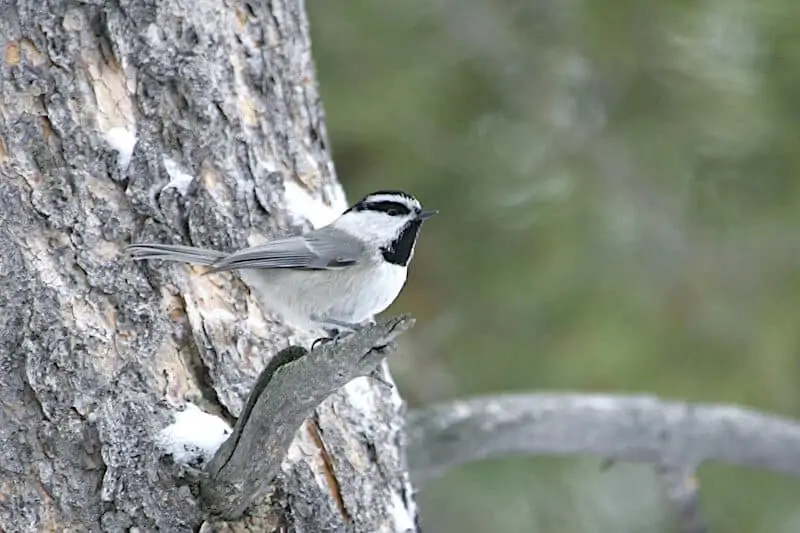
Scientific name: Poecile gambeli
Length: 4.3-5.5 in
Weight: 0.4 oz
Because of their black head and black throat, chickadees are tiny little birds with rounded bodies that are easy to identify. Their underbodies are fluffy and light, and their cheeks are solid white with gray wings and backs. Black-capped chickadees may be seen in Montana, although it’s simple to tell them apart because only the mountain chickadee has the eye stripe above the eye. Evergreen woods in hilly regions are where they prefer to be.
In hilly regions of Montana, especially in the western half, mountain chickadees may be found year-round.
Most seed feeders will be visited by chickadees, who will provide mixed seed blends and black sunflower seeds. In the winter, they might also consume suet.
14. EURASIAN COLLARED-DOVE

Scientific name: Streptopelia decaocto
Length: 11.4-11.8 in
Weight: 4.9-6.3 oz
Wingspan: 13.8 in
The Eurasian collared dove is a European and Asian species that may be expected from its name. They flew to Florida in the 1970s after escaping from a Bahamas pet store. These escaped birds, as well as others released on Guadeloupe in the south Caribbean, are believed to have started the colonization of the United States. They can now be found in most of the United States. In addition to Mexico, there are other countries. These have a chunkier body and a longer tail than mourning doves. They have a plain back with a black stripe across the back of their neck, but they lack the black markings on their backs that a mourning dove has.
Throughout the year, Montana is home to the Eurasian collared dove.
Doves from Eurasia will visit backyards to eat platform feeders and loose seeds and grains. Millet is particularly delicious to them.
15. SONG SPARROW
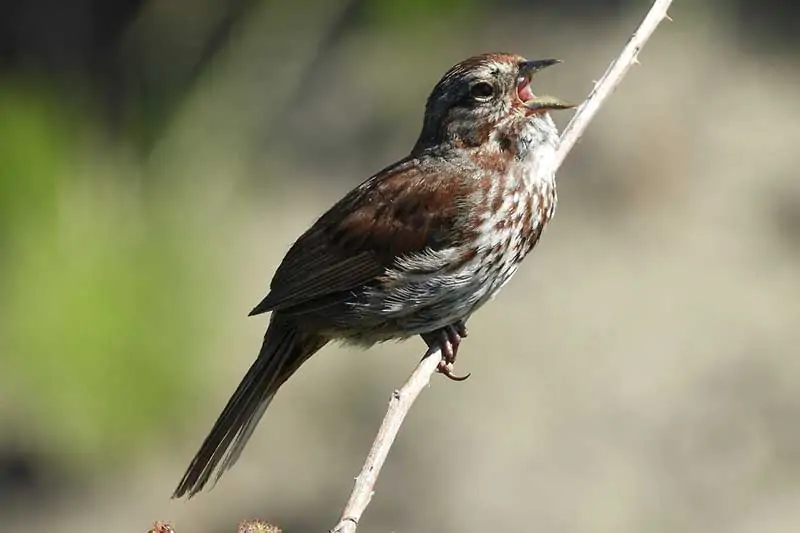
Scientific name: Melospiza melodia
Length: 4.7-6.7 in
Weight: 0.4-1.9 oz
Wingspan: 7.1-9.4 in
Song sparrows have a white breast and are mostly brown on the back and wings, similar to many other sparrows. The song sparrow’s plumage varies somewhat from area to area and is ubiquitous across most of North America. In order to attract females and preserve his territory, the male of the species utilizes his song.
Song sparrows may be seen all year in western Montana, however they only migrate to the state for the spring and summer months in central and eastern areas of the state.
Bird feeders are occasionally visited by Song Sparrows, who enjoy mixed seeds and sunflower seeds.
16. BLUE JAY

Scientific name: Cyanocitta cristata
Length: 9.8-11.8 in
Weight: 2.5-3.5 oz
Wingspan: 13.4-16.9 in
In North America and the United States, another well-known bird species is the American robin. The blue jay is the one in blue. They have blue feathers along their back and wings, and a enormous blue crest on top of their heads. Their neck is ringed in black, and their breast and belly are white. They have a white ring around their neck. Black stripes and barring cover their wings and tail. The same coloration is seen on both sexes in females and males. Blue jays are frequently among the first to notify all the birds in the vicinity of a nearby predator, such as a hawk, and they have several loud, metallic sounding calls.
Throughout the winter months, blue jays may be found mostly in Montana, but they may also stay along the eastern border throughout the year.
Platform feeders, peanut feeders, and feeders with larges perches are all favorites of the Blue Jays. Black sunflower seeds, mixed seeds, and peanuts are all offered.
17. YELLOW WARBLER

Scientific name: Setophaga petechia
Length: 4.7-5.1 in
Weight: 0.3-0.4 oz
Wingspan: 6.3-7.9 in
The yellow warbler is a bright yellow bird with a bright yellow head. Their chest and head are lighter, while their back is darker, olive yellow in color. Males have reddish-brown streaking on their chests. Thickets and small trees near water bodies or streams are where they prefer to live. During the winter, they spend time in Central and South America, where they fly a long distance.
Throughout the spring and summer, Yellow Warblers may be found across Montana.
Insect eaters, thus black warblers will not go to bird feeders. Planting tiny trees that caterpillars can eat may help you attract them.
18. DOWNY WOODPECKER
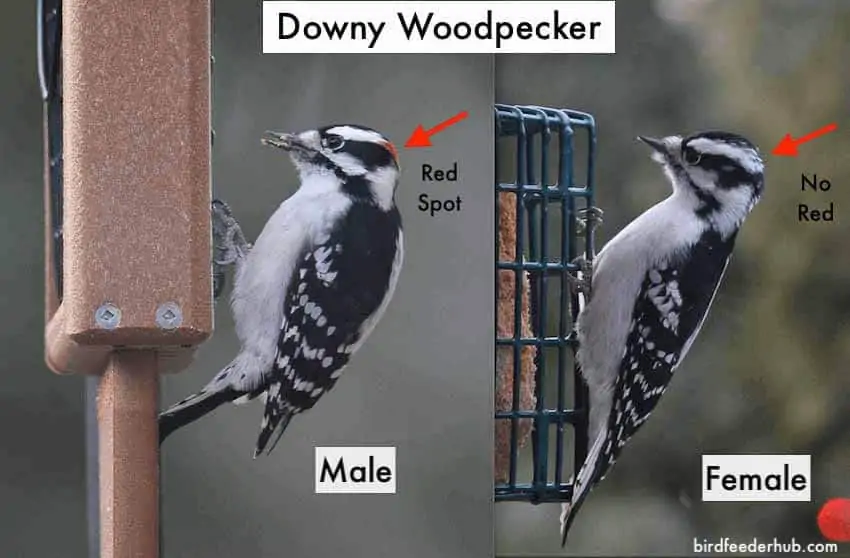
Scientific name: Picoides pubescens
Length: 5.5-6.7 in
Weight: 0.7-1.0 oz
Wingspan: 9.8-11.8 in
The common backyard birds, the downy, are fond of visiting bird feeders. They are one of the first species I notice at a new bird feeder, and they are the littleest woodpeckers in North America. Their crimson spots on the back of their heads (in males, females have no crimson) and their all white underbodies distinguish them instantly. Their black wings with white specks, black and white striped skulls, and red spot on the rear of their skulls distinguish them even more. Downy’s are smaller than Hairy Woodpeckers, despite their similar appearance.
Montana is home to the downy woodpecker, which can be found all year.
At most types of bird feeders, Hairy Woodpeckers are very common. Mixed seed, black sunflower seed, and suet should be offered.
19. CEDAR WAXWING

Scientific name: Bombycilla cedrorum
Length: 5.5-6.7 in
Weight: 1.1 oz
Wingspan: 8.7-11.8 in
The distinctive color of cedar waxwings makes them easy to spot. The tawny brown head and breast, yellow belly, dark gray wings, and yellow-tipped short tail of these medium-sized birds. Their heads are rimmed in white and topped with a enormous fluffy brown crest. Their looks feature a dramatic black eye mask. Little, red, waxy nubs at the tips of their wings give the waxwings their name. These are typically challenging to detect and no one knows what they do. They might help you find love.
One of the few North American birds that can subsist on fruit alone for many months is the cedar waxwing, which enjoys fruit. Insects and other foods are supplemented to their diet, but they may eat up to double the amount of fruit as other birds.
Montana has a variety of cedar waxwings throughout the year.
Seed feeders are not safe for Cedar Waxwings to eat. Native trees and shrubs that produce little fruits and berries may entice them to your property.
20. DARK-EYED JUNCO

Scientific name: Junco hyemalis
Length: 5.5-6.3 in
Weight: 0.6-1.1 oz
Wingspan: 7.1-9.8 in
The dark-eyed junco is divided into several subspecies throughout the United States. Those that have various color variations. The Oregon and pink-sided varieties are popular in Colorado. However, the slate-colored and white-winged birds may be others. You should be able to tell them apart with the help of a decent bird identification book. The pale pink beak and roundish body shape of dark-eyed junco’s are two excellent characteristics to look for when identifying them in general. In addition, the head and back are normally darker, while the belly is usually lighter.
Most of Montana’s dark-eyed juncos are year-round residents, although they may only be winter birds in the north and east.
Juncos favor eating seeds on the ground and will occasionally visit hanging feeders. On the ground directly under bird feeders, you’ll often see them picking up spilled seeds.
21. CHIPPING SPARROW
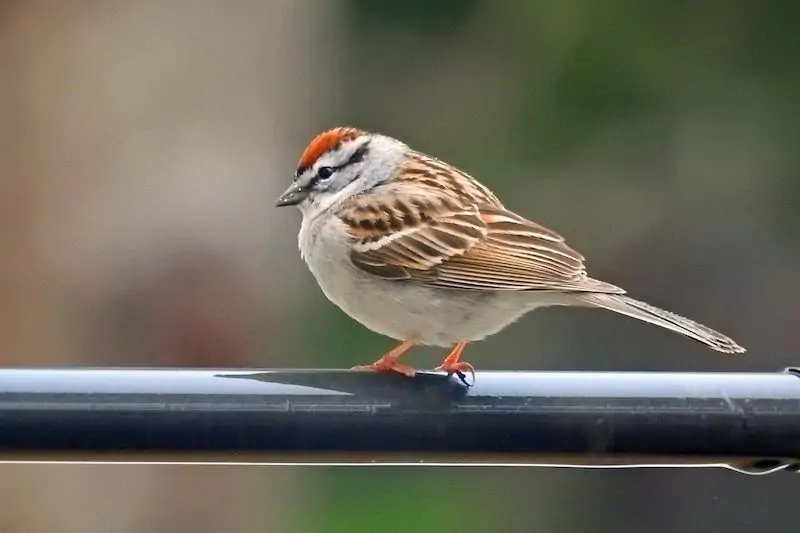
Scientific name: Spizella passerina
Length: 4.7-5.9 in
Weight: 0.4-0.6 oz
Wingspan: 8.3 in
With a buffy gray breast, brown and tan streaked wings, rusty red head, and a black line through the eye with white above, chipping sparrows have their most sharp feathers in the summer. Their patterns may appear less apparent and the color of their winter coats may be more reddish-brown. Sparrows that prefer to feed on open ground are common.
Only during the spring and summer are Chipping Sparrows seen throughout Montana.
Backyard feeders are plentiful with Chipping Sparrows, who prefer to remain on the ground collecting what has fallen. Sunflower and mixed seed, especially scattered on the ground, attract them.
22. BROWN-HEADED COWBIRD
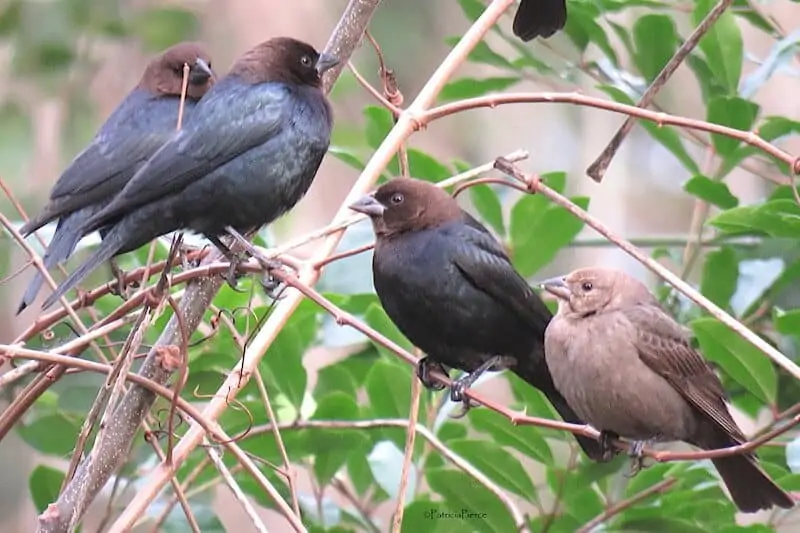
Scientific name: Molothrus ater
Length: 7.5 – 8.7 in
Weight: 1.5 – 1.8 oz
Wingspan: 12.6 – 15.0 in
Because of the color of the males and their propensity to travel in huge flocks (sometimes mixed with genuine blackbirds), brown-headed cowbirds are often classified as “blackbirds.” The iridescent black body of males contrasts with the dark brown head. The whole body of females is lighter brown.
Cowbirds, on the other hand, are nest parasites who parasitize the nests of other species and reduce the population of those species. They may sneak in and lay one egg among the others or kick other eggs out of the nest to make room for their own. Several birds are deceived by the look-alike egg, and they treat the egg as their own.
In Montana, you can findcowbirds throughout the year.
Feeders are attractive to brown-headed cowbirds, who may congregate in large numbers. Mixed seed is almost guaranteed to be eaten.
23. HOUSE WREN
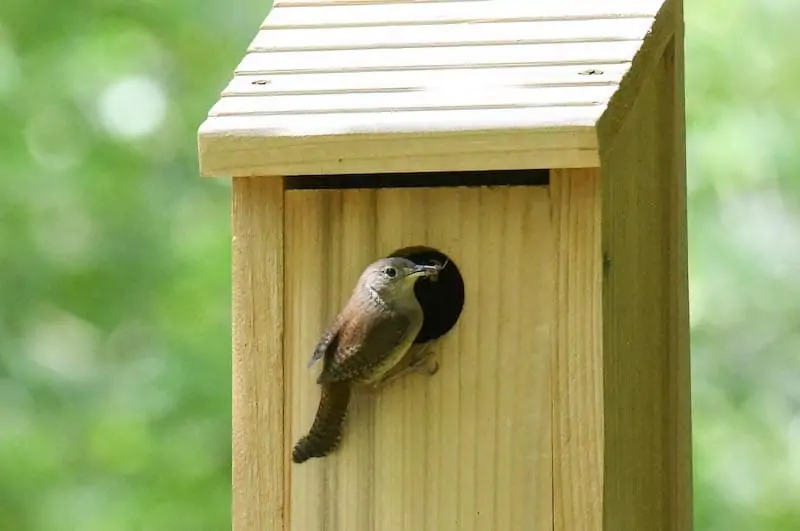
Scientific name: Troglodytes aeon
Length: 4.3-5.1 in
Weight: 0.3-0.4 oz
Wingspan: 5.9 in
The brown bird with a loud voice is the house wren. They’re widespread in the United States, and they’ll nest in practically any tiny space that they think is suitable, including boots or old cans. Bird houses will almost certainly be inspected at the very least, and if they aren’t used, they’ll probably choose to. These are the birds that have chosen my birdhouses to breed in most often. Although their drab color and tiny size make them difficult to see, House Wrens are most likely zipping around through the bushes in your yard catching insects. Their wings and tail feature black barring, with the former being dark and the latter being light.
During the spring and summer months, house wrens can be found all throughout Montana.
House wrens don’t go to bird feeders because they eat virtually exclusively insects and spiders. Nonetheless, having insect-supporting plants or a birdhouse in your yard is likely to draw them.
24. NORTHERN FLICKER

Scientific name: Colaptes auratus
Length: 11.0-12.2 in
Weight: 3.9-5.6 oz
Wingspan: 16.5-20.1 in
In the United States, these medium to enormous woodpeckers are ubiquitous in suburban areas. They are, in my opinion, some of North America’s most colorful birds. Flickers, unlike other woodpeckers, prefer to find insects on the ground rather than in trees, and are mainly insectivorous. The black marks on their bellies, solid black bib, barred black and gray wings, and light brown and gray head will help you identify them. Males will have a mustache, whereas females will not.
In the United States, there are two distinct color variations, the yellow-shafted and the red-shafted. The hue under the wings and tail is different, as well as the hue of the men’s mustaches. They occasionally interbreed and create a hybrid, so you may have seen something that resembles a mix of both.
Throughout Montana, Northern Flickers may be found all year.
Despite the fact that Northern Flickers do not visit feeders as frequently as other woodpecker species, they will eat suet. You may see them digging around for bugs if you have some leaf piles in the yard.
25. WESTERN MEADOWLARK

Scientific name: Sturnella neglecta
Length: 6.3-10.2 in
Weight: 3.1-4.1 oz
Wingspan: 16.1 in
The wings and back of a breeding adult western meadowlark are heavily streaked, the chest, neck, and face are bright yellow, the brow is bold white, and the bib is black. The yellow of immature and non-breeding birds is considerably lighter, and the black chest patch is usually missing. Their distinctive “flutelike” tune, which is often performed from perches on fence poles, is well-known. They eat insects and seeds in grasslands, meadows, and pastures, and are often seen in flocks.
During the spring and summer months, Western meadowlarks can be found in Montana.
They may come to your yard for seed if you live in an open environment. A platform feeder or a ground-fed feed is more likely to be used. Hulled sunflower and broken maize are used in this recipe.
26. YELLOW-RUMPED WARBLER
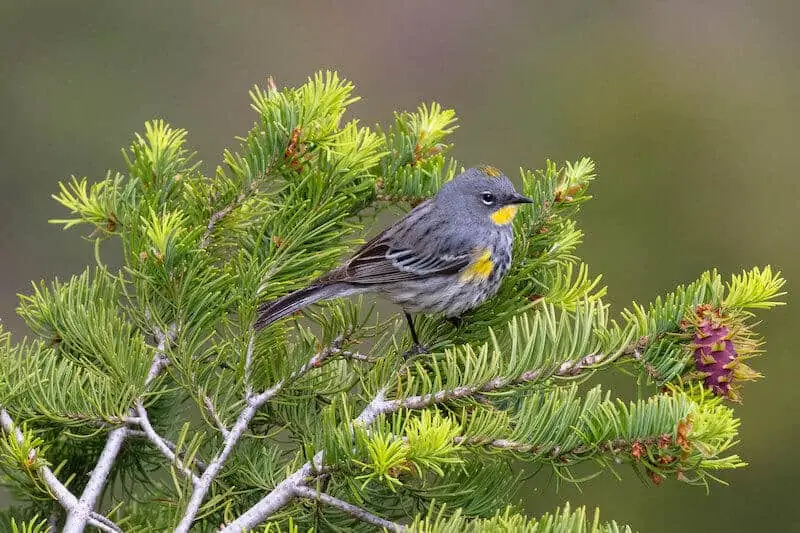
Scientific name: Setophaga coronata
Length: 4.7-5.5 in
Weight: 0.4-0.5 oz
Wingspan: 7.5-9.1 in
Depending on its location, the yellow-rumped warbler’s color pattern may change. The Audubon’s variety, which has bright yellow on the throat, rump, and sides, is most common in Montana. On top of their head, you may even see a little yellow. Females have a similar color pattern, but the colors are less vibrant and the lines aren’t as apparent as in males. In the spring, their colors will be the most vibrant, and by the winter, they’ll have faded significantly. Like other warblers, they’ll fade throughout the winter.
These warblers are only seen throughout spring and autumn migration in most of Montana, however they may spend the summer along the state’s far western border.
Bird feeders attract yellow-rumped warblers on occasion. Sunflower seeds, suet, and raisins are all good ways to attract them.
HOW TO ATTRACT BIRDS TO YOUR YARD
Want to attract some of these birds to your property? Take a look at these five basic principles, beginning with the most basic.
1. PUT OUT BIRD FEEDERS
Planting a bird feeder or two is the greatest and simplest way to attract birds to your property. A simple tube feeder, hopper feeder, platform feeder, or window feeder are all good options to get started. For more information, see the sections below.
2. ADD A WATER SOURCE
You can use a terra cotta flower pot saucer, like this one, instead of a pedestal birdbath like the one on Amazon. Birds need water not only to wash in but also to drink, which will increase your chances of attracting birds by adding a water feature to your yard. Consider installing a solar fountain to give the birds an even stronger incentive to visit the water.
3. OFFER BIRDHOUSES
If placed in the proper location at the proper time of year, several bird species will readily take up residence in birdhouses. Among the most popular birds sought after for birdhouses are Eastern Bluebirds. The same day I put up this birdhouse, a mating pair of bluebirds was investigating it in my back yard.
4. PROVIDE SHELTER
Make sure there are trees, plants, and shrubs for the birds to hide in when they sense danger in your yard. Predators are their primary threat, and this is their primary defense. Try to landscape components that will allow birds to view your yard as safe if your yard is in a new neighborhood with no mature trees.
5. ADD NATIVE PLANTS
Having native plants that produce nuts, berries, and seeds will merely help your efforts to attract more birds for many birds that eat them. Native birds that are not accustomed to these plant species may be harmed by invasive and non-native plants.
10 DIFFERENT TYPES OF BIRD FEEDERS
People put up ten of the most prevalent bird feeders in their yards.
- The term “hopper feeder” refers to a bird seed holding compartment in the middle of a hopper feeder. Birds can land on the sides and eat from perches. Many hopper feeders have a house shape and are topped with a lid to keep the seed dry. For this kind of feeder, use black sunflower seeds or a combination of birdseed. This squirrel-proof hopper feeder is one of my favorites.
- Platform feeders are open on top and can be hung from a tree, hook, or pole-mounted. They’re sometimes known as tray feeders. They’re simple to set up and suitable for feeding practically any kind of bird. Every animal in your yard that can reach them will eat from them, despite the fact that they are completely open. For this kind of feeder, use black sunflower seeds or a combination of birdseed. In my yard right now, I’m using this platform feeder.
- Tube feeders are transparent plastic tube-shaped bird feeders that are used to feed birds. They might hold a few seed cups or 5 pounds or more, and may be of various sizes. They’re wonderful since they allow you to quickly seed when it’s time to refill, while also keeping your seed fresh and dry. Tube feeders are used by several sorts of birds. Tube feeders can be used with black sunflower seeds and mixed seeds. This squirrel-proof tube feeder is made by Squirrel Buster, and it’s one of their best.
- Suet feeders are used to feed suet cakes, which are only suitable for one kind of bird. They are a fairly basic design, generally consisting of a metal wire cage with a tail-prop for bigger birds. Suet feeders are common in the winter, when birds are seeking for high-fat foods and woodpeckers are frequently seen there. I recommend the Pileated and Northern Flicker for attracting bigger woodpeckers, such as a suet feeder with a long tail prop.
- Window feeders are small bird feeders that use suction cups to mount them right onto a glass window. They’re open on top and you pour seed into the tray area to replenish them, similar to tray feeders. Many different types of birds appreciate these feeders, they are simple to set up, and they are ideal for folks with small yards. For this type of feeder, use black sunflower seeds or mixed birdseed. This is by far the most well-liked bird feeder on Amazon, and maybe on the whole internet.
- Thistle feeders, sometimes known as nyjer feeders, are specialized bird feeders that are designed exclusively for thistle seed. Birds in the finch family, which includes the American Goldfinch and House Finch, are among the species that thistle feeders attract. Thistle feeders, which contain small holes all around the tube, enable the birds to pick thistle from them. They are frequently in a tube shape. Droll Yankees has a nice thistle feeder for you.
- More or less tray feeders that sit on the ground level, ground feeders are more or less Tray feeders. Birds like Mourning Doves, Juncos, and squirrels, as well as raccoons and any other kind of ground animal, will adore them. For this kind of feeder, use black sunflower seeds or a combination of birdseed. This recycled plastic ground feeder is a good choice for you.
- Oriole feeders are a kind of specialty feeder that is used to feed only one kind of bird, orioles. The feeder is usually orange in hue and includes tiny plastic or glass jars for holding jelly, which orioles adore. Another food that orioles enjoy is orange halves, which they also allow you to stick onto the feeder. A simple oriole feeder with four jelly trays will hold orange halves for you.
- Hummingbird feeders, also known as hummingbird feeders, are made to capture sugar water from hummingbirds. I regularly see Downy Woodpeckers at my feeders, despite the fact that they are meant for hummingbirds. For instructions on how to make hummingbird nectar without boiling the water, see this page. There’s no need to spend a lot of money on a hummingbird feeder since they’re simple and inexpensive.
- Peanut feeders are tube-shaped and typically made of metal wire mesh material. They’re similar to thistle feeders in appearance. To enable for whole unshelled or shelled peanuts to go through the holes, the openings in the wire mesh are considerably farther apart. These should be filled with peanuts and attract birds like Blue Jays. This squirrel feeder by Squirrel Buster is the best way to keep squirrels out of your peanut feeder. This basic one will suffice in a pinch.
BIRD WATCHING IN MONTANA
If you want to go out and about with your hobby, Montana is a fantastic state for birding. If you want to get more engaged, the Montana Audubon Society hosts meetups, seminars, field excursions, and birding adventures on a regular basis.
Take a look at this list of popular birding sites in Montana if you’re a Montana resident who’d like to add some new species to your life list.
MONTANA BIRDING LOCATIONS
From birdwatchersdigest.org, you may learn more about the different sites’ offerings.
- Glacier National Park
- Swan River National Wildlife Refuge
- National Bison Range
- Benton Lake National Wildlife Range
- Ulm Pishkun State Park
- Medicine Lake National Wildlife Refuge
- Bowdoin National Wildlife Refuge
- Lee Metcalf National Wildlife Refuge
